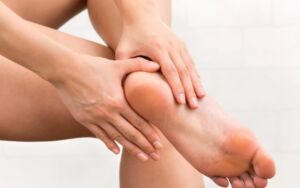1. Keep your feet as clean as you can
It might seem obvious, but during summer it’s especially important to keep your feet clean. You’re more likely to be wearing open shoes – or no shoes at all – and in addition, the extra heat means your feet may be sweating more than usual. Not drying your feet properly and not keeping your feet clean can create the ideal environment for fungal infections such as athlete’s foot. This can cause red, flaky skin to form on the feet, and produce cracks or blisters.
To combat this, wash your feet daily with a gentle, hydrating cleanser that won’t dry out the skin. Try to avoid cleansers that strip your skin of its natural oils, as to avoid dry, cracked heels, it’s important for your feet to keep their protective moisture barrier intact.
2. Exfoliate after bathing or showering
Exfoliation is key in preventing cracks from forming, as it helps to remove dead skin and prevent thick, rough buildups on the heels and soles. After showering or bathing, or giving your feet a soak, use a foot file to help remove dead skin and rough patches. Avoid foot files which look more like cheese graters, as these files may have sharper ‘teeth’ that can cut or scrape your feet. Then, once you’ve given your feet a gentle exfoliation, you can move onto your next step, which is all about returning hydration to dry, cracked heels.
3. Use a rich moisturizer
Your heels are often at their worst during winter, as there is less humidity in the air. What does this mean for your feet? Less humidity causes the skin to become drier, so your feet are more likely to peel and crack during these colder months. If you want to repair dry, cracked heels and keep your skin soft and smooth year-round, then it’s a good idea to moisturize feet daily. Use a rich foot moisturizer that will help maintain optimal moisture levels and make skin feel softer.
In summer a moisturizer might be the last thing you want to reach for, but by using a foot cream which has a lighter texture, such as ISDIN Uradin Podos Gel-Oil, you can help deeply hydrate your skin while avoiding the greasy, sticky feeling that many foot moisturizers or heel balms leave behind.
4. Wear socks made from natural fibers
While you might not be wearing socks as frequently over the summer months, foot care is important year-round, and this tip is equally valid in the heat as it is in winter! To help in the prevention of dry, cracked heels, wear socks that are made of natural materials, such as wool or cotton, as synthetic fibers will make your feet sweat more. In addition, synthetic fibers don’t absorb moisture as well, so your feet might be wet and sticky for longer periods of time with synthetic socks.
If you want to help lock in moisture after using a foot cream, then wear socks after application. Wearing socks overnight can help keep your feet hydrated, though it’s probably best to try this trick out in the colder months when feet are more likely to dry out. In summer, moisturize your feet and sit back for 15 minutes or so (with or without socks!) to let your feet absorb the hydration, and give your tired feet a well-deserved rest.

